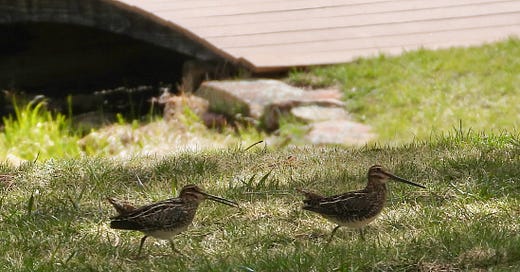The sun is going down on a spring evening, and as the other birds begin to quiet for the night, another sound rises. Whoo-whoo-whoo-whoo. Doppler effect, it flies by you, but you can’t see it. Where is it? Another pass, it feels so close and yet you cannot find where the sound comes from. Whoo-whoo-whoo-whoo. Soon, finding the source feels futile. You’ve gone on a ‘Snipe Hunt’. Listen below.
Oh, you thought Snipe Hunts were for summer camp? A flashlight and pillow case, making a silly sounding bird call. Historically, a fools’ errand, a pointless task, a practical joke style going back nearly 200 years. The joke usually ends with ‘fool me once’, but the victim quickly wants to turn the tables and lure others into it.
The sound is real, though, and we know where it comes from. The Wilson’s Snipe. An off-kilter looking bird, taller than a robin, on legs that walk a good deal through soggy areas. Did you catch the sound of the winnowing in the recording? The other call is also the snipe, which I’ll get to below. Part of the Sandpiper family of birds, their toes are a long, splayed arrangement for keeping afloat in wet bogs. Their bellies are cream colored with wings and body of brown and cream, speckled and stripped, perfect for hiding in the wetlands. Their off-balance look comes from their long, narrow bills, and surprisingly short tails, like they are about to tip forward. Long bills are intricately designed for poking into marshland mud for bugs and worms. The bill becomes a flexible straw to slurp up tasty bits.
Their most notable trait, though, is that sound. The sound can be reminiscent of the plastic tubes we played with as kids that produce a low whistle sound when swung in a circle, but, ugh, no, not quite. It is unique, elusive and just when you think you’ve seen the bird, no, you missed it. Then, just sure we’ll never see the snipe, a pair walks right up to my office door.
Learning more what to watch for, we do start to see Snipes in flight, even. Thank Google, we began to understand some of their secrets. That sound, part of mating and territorial communication, is from their outer tail - yes, there is a tail! - feathers. They fly up high, where they turn around and drop into a dive, hitting speeds above 25 miles an hour, the faster, the louder. Their tail feathers spread, and the air speeds through the delicate feathers, creating vibrations like the reed in a clarinet. In most other tail feathers, there are interlocking barbs that cause the feather to become a flat surface for flight. A Snipe’s outer tail feathers do not have these barbs, so the air whistles on through and makes the winnowing, drumming, or bleating call. Aha! There’s the secret that is so elusive.
Most often heard at dawn and dusk - that’s called crepuscular, kids! - it is so hard to see where the sound is coming from in the faint light. This year, in our wetlands, we have at least two, and likely more, mated pairs of Wilson’s Snipes that are active all day long. This is an unusually busy year for the Snipes, and they have made their presence known in sound and their surprising strolls through the property. So, we finally get to see them, in all their goofy glory. We have also learned to watch them in flight. Small black dots shooting high into the air to then turn to a dive and, ah, there’s the sound. This Spring has not been quite as wet as the past few, and so the lower humidity causes the winnowing sound to carry further. Truly, it all seems for the fun of it. Their serious communication has the feel of a sense of joy in their dives and the winnowing sound, like whoops of skiers or surfers.
The other sound that has been consistent with them this spring is their ‘pips’. Pip, pip, pip, pip, about 4 per second and pipping-off a couple dozen at a time, they claim their territory. You cannot mistake the snipes are here.
The Snipe is not just local to wetlands in the Foothills though. Worldwide, various cultures have developed stories of the sound they can’t find the source of. From Indigenous Alaskans likening the sound to the walrus, to the sound of a ghost horse’s whiny to the Swedish, to the ancient Germans likening the sound to bleating goats, or more specifically, Thor’s goats carrying his chariot across the heavens. Well, that’s what Wikipedia stated. The sound has pervaded cultural curiosity and stories. What we cannot explain easily becomes great fodder for creative concepts, or silly pranks.
Thank you for stopping by. While my normal life is full with my paying job, other volunteer work, and family time, I write these posts out of my own naturalist curiosity, and love of writing and photography. Many times, this blog has to take a back seat to my other obligations, but I always have the next post on my mind. My subject matter is limitless! If you have enjoyed these posts, I would ask for your support of my work here. Please consider subscribing or upgrading to a paid subscription, and do share what you have enjoyed. I am working on at some benies for paid subscribers of artwork from Itsthemoonart©️, whose artwork has appeared in other posts and my logo (my naturalist-artist daughter and content advisor) and other ideas. I am very thankful for all my subscribers and supporters! Please let me know if you have ideas you’d like to see a post about!
Sources:
- https://www.discoverwildlife.com/animal-facts/birds/snipe-drumming-how-does-a-snipe-drum
- https://www.eastsideaudubon.org/corvid-crier/2022/4/wilsons-snipe
- https://blog.nature.org/2020/06/23/the-winnowing-of-the-wilsons-snipe/
- https://en.wikipedia.org/wiki/Drumming_(snipe)
- https://www.allaboutbirds.org/guide/Wilsons_Snipe/overview#
- https://www.audubon.org/field-guide/bird/wilsons-snipe
📷 All photos are credit: The Abert Essays unless otherwise noted.
📱 Join me on my Facebook page and other social media. I post smaller ‘Encounters’ posts there as I see flowers, animals, weather patterns, and anything else that catches my eye.









